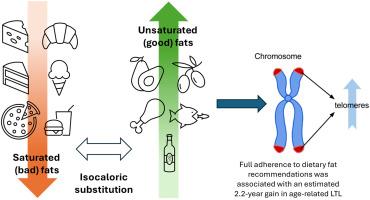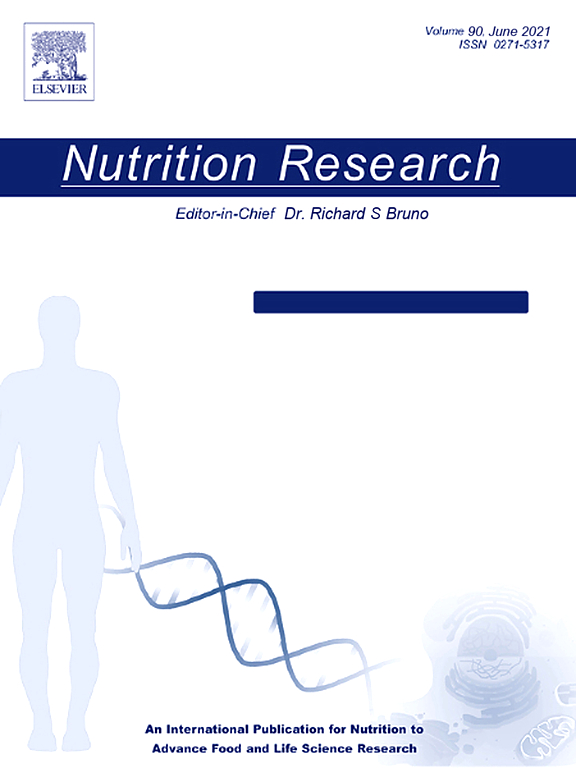Higher dietary n - 3 PUFA and fiber intake are associated with longer leukocyte telomere length: Evidence from a substitution model analysis in the UK Biobank
IF 3.1
3区 医学
Q2 NUTRITION & DIETETICS
引用次数: 0
Abstract
Telomere attrition is a biomarker of cellular aging, influenced by lifestyle and dietary exposures. The specific role of macronutrient composition, particularly polyunsaturated fatty acids (PUFAs), in telomere dynamics remains insufficiently explored. We hypothesized that higher intake of specific macronutrients, particularly PUFAs, would be positively associated with leukocyte telomere length (LTL). In this cross-sectional study of 143,553 UK Biobank participants aged 40-69 years, we examined associations between macronutrient intake and standardized LTL (z-LTL), measured as the log-transformed telomere repeat to single-copy gene ratio. Dietary intake was assessed using repeated 24-hour web-based dietary recalls. Multivariable linear regression models were used to estimate associations between macronutrients (% of total energy intake) and z-LTL, adjusting for demographic, lifestyle, and clinical covariates. Effect estimates were translated into age-equivalent changes in LTL. Carbohydrate and total fat intake were positively associated with z-LTL, corresponding to age-related LTL differences of approximately 30-40 days. In energy substitution models, n - 3 PUFA intake showed a stronger positive association with z-LTL than other fats, with adherence to recommended intake associated with differences equivalent to over 2 years (P < .0001) of age-related telomere shortening, whereas no evidence of an association for MUFA was observed. Energy-adjusted fibre intake was associated with an age-related change of LTL equivalent to 1 year (P < .0001). These findings suggest that dietary composition, particularly n - 3 PUFA intake, may be linked with LTL in a manner consistent with healthier cellular aging. Further longitudinal and experimental studies are needed to confirm these associations and explore their implications for dietary guidance.

较高的膳食n - 3 PUFA和纤维摄入量与较长的白细胞端粒长度相关:来自英国生物银行替代模型分析的证据。
端粒磨损是细胞衰老的生物标志物,受生活方式和饮食暴露的影响。宏量营养素组成的具体作用,特别是多不饱和脂肪酸(PUFAs),在端粒动力学仍未充分探讨。我们假设摄入更多的特定常量营养素,特别是PUFAs,与白细胞端粒长度(LTL)呈正相关。在这项对143,553名年龄在40-69岁之间的英国生物银行参与者的横断面研究中,我们检查了常量营养素摄入量与标准化LTL (z-LTL)之间的关系,以对数转化端粒重复与单拷贝基因比率来测量。通过重复的24小时基于网络的饮食回顾来评估饮食摄入量。多变量线性回归模型用于估计宏量营养素(占总能量摄入的百分比)与z-LTL之间的关系,并对人口统计学、生活方式和临床协变量进行了调整。效应估计被转化为LTL的年龄等效变化。碳水化合物和总脂肪摄入量与z-LTL呈正相关,与年龄相关的LTL差异约为30-40天。在能量替代模型中,与其他脂肪相比,n - 3 PUFA摄入量与z-LTL表现出更强的正相关,坚持推荐摄入量与年龄相关的端粒缩短的差异相当于超过2年(P < 0.0001),而未观察到与MUFA相关的证据。能量调节纤维摄入量与年龄相关的LTL变化(相当于1年)相关(P < 0.0001)。这些发现表明,饮食成分,特别是n - 3 PUFA摄入量,可能与LTL以一种与更健康的细胞衰老一致的方式相关。需要进一步的纵向和实验研究来证实这些关联,并探讨其对饮食指导的影响。
本文章由计算机程序翻译,如有差异,请以英文原文为准。
求助全文
约1分钟内获得全文
求助全文
来源期刊

Nutrition Research
医学-营养学
CiteScore
7.60
自引率
2.20%
发文量
107
审稿时长
58 days
期刊介绍:
Nutrition Research publishes original research articles, communications, and reviews on basic and applied nutrition. The mission of Nutrition Research is to serve as the journal for global communication of nutrition and life sciences research on diet and health. The field of nutrition sciences includes, but is not limited to, the study of nutrients during growth, reproduction, aging, health, and disease.
Articles covering basic and applied research on all aspects of nutrition sciences are encouraged, including: nutritional biochemistry and metabolism; metabolomics, nutrient gene interactions; nutrient requirements for health; nutrition and disease; digestion and absorption; nutritional anthropology; epidemiology; the influence of socioeconomic and cultural factors on nutrition of the individual and the community; the impact of nutrient intake on disease response and behavior; the consequences of nutritional deficiency on growth and development, endocrine and nervous systems, and immunity; nutrition and gut microbiota; food intolerance and allergy; nutrient drug interactions; nutrition and aging; nutrition and cancer; obesity; diabetes; and intervention programs.
 求助内容:
求助内容: 应助结果提醒方式:
应助结果提醒方式:


